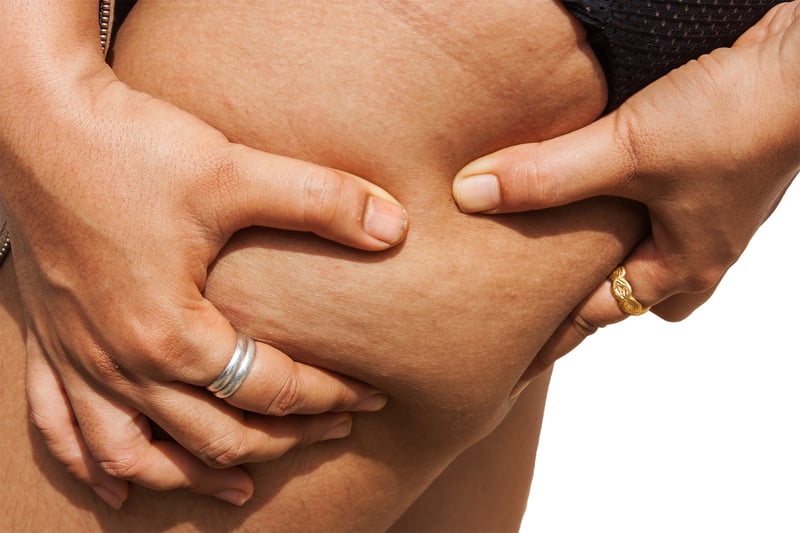Ask the Coaches: How Do I Get Rid of My Cellulite?

Q: It seems that everyone complains of belly fat or being overweight. My problem isn’t that I need to lose weight. I need to reduce my cellulite! I train quite a bit, including HIIT [high-intensity interval training] and weight training 3 times a week, running 2 – 3 times a week (8 – 16km), and doing yoga several times a week. Yet I can’t seem to lose the cellulite. HELP please!
Sincerely,
-Mary
A: Mary, thanks for reaching out to us with your question! I’m know how frustrating this can be. You’re training hard—and frequently—yet you’re not getting the results you desire. Believe me, Mary, you’re not alone. In fact, it’s estimated that about 90% of women over the age of 20 have cellulite, and contrary to popular belief, people of all body weights can have cellulite.
What is cellulite? Well, you already know the answer, Mary, but for those following along, cellulite is defined as a localized metabolic disorder of subcutaneous tissue that alters the local body shape. That’s science speak to say cellulite is the unaesthetically disturbing dimpling appearance of skin, which some refer to as “orange peel” or “cottage cheese-like,” seen most commonly on the thighs, butt, and belly. Not nice, I know.
Here’s the worst part: The cause of cellulite is up in the air. In other words, we really don’t know what causes it. What we do know is that it involves a layer of the connective tissue beneath the skin and the layer of fat just below it. More specifically, cellulite is the result of fat bulging through the connective tissue.
And while it can affect men, it’s far more common in women, which leads many to believe it may have some hormonal basis. However, this phenomenon may have more to do with differences in skin architecture in men and women. For instance, in women, the connective tissue is arranged perpendicular to fat tissue, allowing it to more easily protrude. In men, on the other hand, this arrangement has a crisscross structure, which seems to prevent cellulite.
Overall, even though the cause is unknown, most people agree there are multiple factors involved:
- Structural
- Genetic
- Hormonal
As you’ve probably explored, there’s quite a wide range of products and treatment options available for reducing cellulite, including:
- Topical creams
- Shock-wave therapy
- Radiofrequency
- Laser therapy
- Ultrasound therapy
- Cryotherapy
- Vibration therapy
- Massage therapy
- Carbon dioxide therapy
- Compressive therapy
- Infrared therapy
- Dermabrasion
- Oral supplements
- And others
While some of these forms of treatment hold promise, scientific research has yet to determine a final and definitive form of therapy for cellulite. Beyond that, in the instance that one of these methods does acutely improve cellulite, there’s no evidence to confirm the benefits will last.
Generally speaking, it’s believed that the best results are likely to be achieved from a combination of lifestyle factors that:
- Improve the general state of the skin and connective tissue.
- Improve blood flow.
- Reduce body fat.
Along those lines are some tips to consider that could be helpful:
- Select proper clothing and footwear—wearing clothes that are too tight-fitting can restrict blood flow. Also, wearing high-heeled shoes negatively affects posture and weakens the venous-muscle pump thereby restricting blood flow.
- Quit smoking—nicotine and other substances in cigarettes can cause blood flow restriction, and smoking also induces oxidative stress, which plays a fundamental role in the aging of skin and every cell in the body.
- Stay active—even though it may not seem like your exercise program is helpful, it’s most likely not hurting. An active lifestyle helps improve blood flow, and it can help with fat loss (or, at least mitigate fat gain).
- Consider a low- or controlled-carbohydrate diet—poor glycemic control and insulin management can intensify fat storage and make it difficult to lose fat, especially from stubborn areas.
- Get your gut in order—among the many influences of the gut is the skin. Poor gut health may play an indirect role in cellulite.
- Consider using a topical—creams, lotions, and serums containing caffeine (which is thought to help by increasing fat breakdown), retinol (which may suppress the storage of fat), hyaluronic acid, antioxidants, and/or plant-based extracts may be helpful for tightening, toning, and hydrating skin as well as improving circulation.
- Drink plenty of water—proper hydration is pretty much good for everything, including skin health and metabolism.
That may not be a complete list, but it should be a good start. Cellulite can indeed be frustrating, but these tips should help you reduce the appearance with a bit of time and effort. If there’s anything else I can help with, please don’t hesitate to ask.
-Coach Cristina





